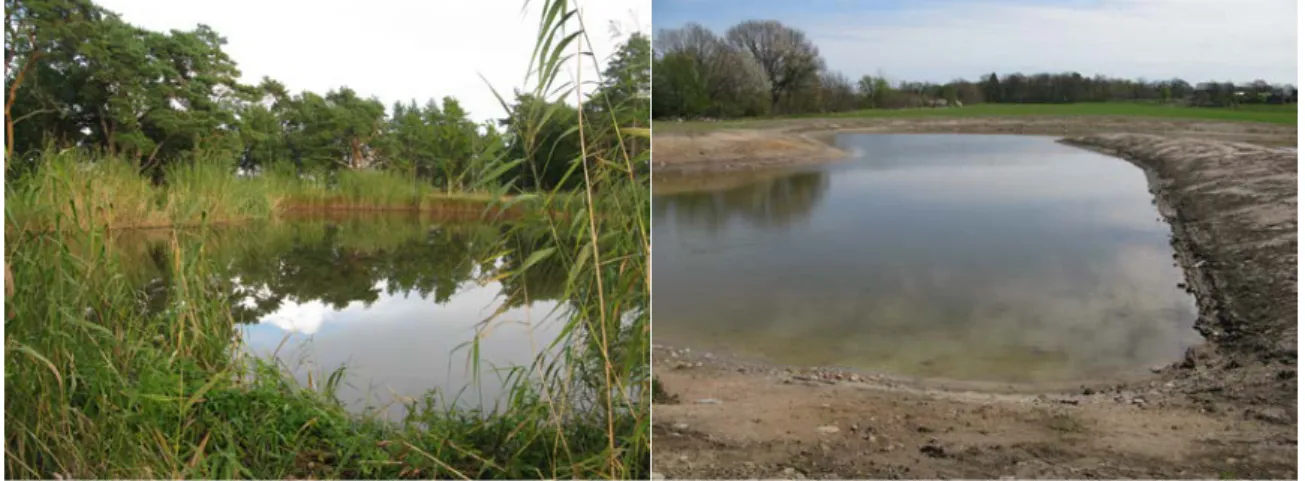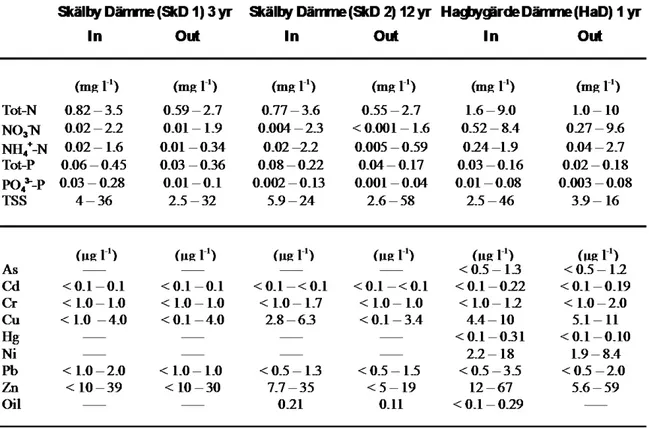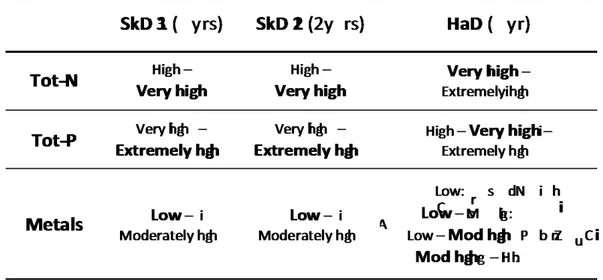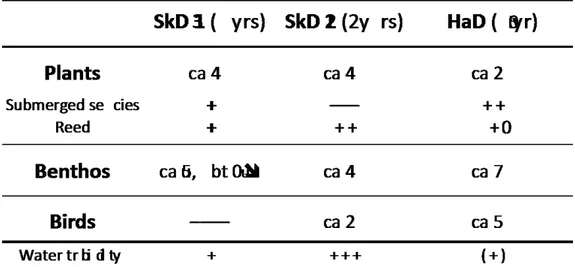TREATING URBAN STORMWATER IN
CONSTRUCTED WETLANDS IN KALMAR,
SWEDEN, FOR IMPROVED WATER
QUALITY AND BIODIVERSITY
Jan Herrmann
Miku Yoshiyama
Department of Biology and Environmental Science,
Linnaeus University, Kalmar, Sweden
Corresponding author:
jan.herrmann@lnu.se
ABSTRACT
Stormwaters’ heavy loads of nutrients, metals and oil etc, via urban ditches / streams, are increasingly treated in engineered shallow wetlands/ponds. Such approaches are still only remedying a minor part of affected storm waters, urban streams, and freshwater and marine recipients. In Kalmar, a middle-sized Swedish town at the Baltic Sea, > 10 such wetlands / ponds are established for reduction of such heavily polluted waters. Aiming at determining the effectiveness in reduction of nutrients and metals, and the facilitation of the aquatic biodiversity (primarily in the wetlands), monitoring programs were initiated. Regular in/outflow water sampling, water flow and biology, were followed for 1-2-3 years (varied with parameter) after construction in two of these wetlands. Skälby Dämme, constructed 14 years ago (2000), showed ca 40 % nutrient reduction figures, less for TSS and metals, while Hagbygärde Dämme, constructed two years ago (2012), attained only much lower results. Reasons for this difference might be that Hagbygärde is less surrounded by forested land, also that less than one year had elapsed before evaluation commenced, while two-three years in Skälby. More recent monitoring in Skälby Dämme is also compared with. Moreover, this kind of wetlands/ponds is shown to favour the biodiversity of benthic invertebrates, (aquatic) plants and birds, although with trends to decline in species richness some years after the initial colonization period.
Keywords: Stormwater, Wetland, Nutrient reduction, Metals, Biodiversity, Invertebrate, Benthos, Plants
1. BACKGROUND
Stormwaters’ heavy loads of nutrients, metals and oil etc, via urban ditches/streams, are increasingly treated in engineered shallow wetlands/ponds. Such approaches are still only remedying a minor part of all impacted storm waters, urban streams, and freshwater and marine recipients [1]. In Kalmar, a medium-sized Swedish town at the Baltic Sea, more
than 10 such wetlands/ponds are established for reduction of such heavily polluted waters.
In order to determine the efficiency of the reduction of nutrients and metals, but also find out to what extent the constructed water bodies also can favour the aquatic biodiversity, monitoring programs were initiated. Regular in/outflow sampling for water chemistry, water flow, and biology were followed for 1-2-3 years (varied with parameter) after construction in two of these ponds (so called hereafter), both located just before the water enters the brackish Baltic Sea, and both receiving stormwater highly loaded with nutrients, metals and oil products.
2. LOCALITIES AND METHODS
Skälby Dämme (SkD), in fact a three-pond system with a channel in between these, in total of 1 ha area, receives water from mainly residential and traffic areas, and is located where was earlier “woody wetland”, thus surrounded by trees and bushes (Figure 1a). The pond system was functioning from May 2000, was evaluated 2002-2004 for water chemistry (first year monthly sampling, then less frequently, always inlet and outlet of the system), but earlier start for monitoring the colonization of benthic invertebrates (hand-net samples, four sites, nine times over 2.5 years) and littoral plants, once each the four first years [1]. The same program was repeated during one year 2011-2012, using the same sampling locations, frequency and chemical and biological parameters. At this time also three seine nets were used during one night, in order to screen the fish community in the pond system. Bird observations for all years were assembled. For both study periods, the standard nutrient parameters and five metals were analysed (Table 1), and also the reductions of these through the pond system were calculated, even if with some uncertainty for the early period (SkD 1).
Figure 1. The studied pond systems; (a) Skälby Dämme 2011-09-08 (11 years old), and (b) Hagbygärde Dämme 2012-05-08 (3 months old).
Hagbygärde Dämme (HaD) partly contained water from March 2012, partly drained April–October, but in full use from October the same year. It is also composed of three ponds, though more separate from each other than they are in SkD, with a total area of ca 1 ha. The water has similar origin as for SkD, but more roads and old industrial grounds,
giving higher loads with nitrogen and metals, but lower with phosphorous (Table 1). HaD is located/excavated on earlier arable, grazing or impediment areas, but quite little of woody land (Figure 1b). Water samples were taken from October 2012 to December 2013, at inlet and outlet of the system, and analysed for mainly nutrients and metals (Table 1). The colonization of benthic invertebrates was monitored by hand-net sampling eight times over 1.5 years, at five sites. Aquatic plants were surveyed mainly in Sept/Oct 2013, and bird observations were assembled from ornithologists [2].
Table 1. Range of water chemistry values for Skälby Dämme after 3 and 12 years, and Hagbygärde Dämme after ca 1 year.
3. RESULTS AND DISCUSSION
In general, the concentrations of the analysed chemical parameters were of similar magnitude in Skälby Dämme (SkD) and Hagbygärde Dämme (HaD) (Table 1). However, SkD exhibited higher levels of Tot-P and phosphate than did HaD, whereas the opposite was clear for the other parameters, i.e. Tot-N, nitrate, ammonium and all metals, even if for some of the latter less obvious, partly due to that concentrations were below the detection limits. These statements are valid for both incoming and outgoing water samples, and in SkD for both the early and later periods of sampling (Table 1).
When breaking up these range figures (Table 1) into the details, and evaluating them with the official Swedish quality criteria used for surface waters [3], as lakes, the outcome indicates that these stormwaters are highly polluted with nutrients (Table 2). Metals
exhibit a whole range from low to moderately high, especially copper exhibited high concentrations, probably due to its increased use in braking pads in cars. However, as stormwater could possibly “be allowed” to show higher levels than lake waters, a more fair comparison can be to use the so-called target levels for stormwater [4] Then only Tot-N figures are above these levels, all other parameters are below.
Table 2. Labels on the outcomes from scoring dominating/typical concentration levels of chemical parameters in SkD 1 (=2002-2004), SkD 2 (=2011-2012), and HaD (= Hagbygärde Dämme 2013). The scoring is based upon the Swedish Environmental Quality Criteria [3]. When an intermediate outcome is given, the score in bold letters indicates the dominating one.
Although based on only monthly water samples, SkD perform around 40 % reduction for both Tot-N and tot-P, and during both period SkD 1 and period SkD 2, considering water flow variation, but the actual water sampling was not proportional to the water flow. Nevertheless, these reduction figures are relatively acceptable [1, 4]. Reduction figures for metals were not calculated for SkD.
Due to unreliable functions of the water flow measuring facility, flow-based calculations of reduction were not performed for the HaD for this first period of function (2013). Nevertheless, by using the In- and Out-flow figures for the chemical parameters it was indicated that for most chemical parameters of pollutants, the reduction was low; only ammonium and nickel, lead and zinc showed significance in pairwise t-tests. A similar series of t-tests of the SkD data showed clear significances, thus the HaD pond system at least initially seemed to exhibit poor reduction, compared to SkD [2].
Reasons for this difference might be that Hagbygärde Dämme experiences a relative scarcity on the bottom of organic material (fine detritus ≈ settling TSS), as being less surrounded by forested land, and not time enough for receiving such from upstream. This might give less of carbon source for the denitrification, reducing nitrogen to nitric gas, and also less phosphorous binding capacity at the bottom [1, 6]. If so, the water sampling/evaluation commenced too early, in fact almost immediately whereas after two
years in Skälby Dämme. A repeated sampling program In HaD is to start in 2015, and this will hopefully shed more light on the question whether perhaps a satisfactory status is attained not until a few years after the start of a wetland/pond system with the objective to reduce pollutants.
The great importance of this kind of urban water bodies for the aquatic, but also terrestrial, biodiversity is often forgotten, and seldom evaluated. Both these two pond systems, Skälby Dämme and Hagbygärde Dämme, contain a good variety of plants, benthic invertebrates, and birds (Table 3). However, SkD seemed to faster attain a more complete setup of species, more resembling of the earlier years in Kalmar Dämme [7]. This is a much larger wetland/pond system close to HaD, therefore its role as a recruitment area for a rapid development of biodiversity in HaD might be important.
Table 3. Number of species of plants, benthic invertebrates and (“water-related”) birds, and other traits in Skälby Dämme 3 years from start (SkD 1), 12 years (SkD 2), and Hagbygärde Dämme 1 year after start (HaD).
Numbers of water-related (“higher”) plants seem to develop at a level of ca 40 species (Tab. 3). It was also found that common species tend to dominate more with time, while more rare species are outcompeted, confirming Tonderski et al. [8]. Unfortunately the initial stock of much submerged vegetation declines with time, and simultaneously the water turbidity increases, maybe partly due to the illegal introduction of carp and other fish species. Over time, graminid (“grass”) species, especially reed, increase into dominance, as also seen in Kalmar Dämme (Table 3). These plant tendencies will disfavour the nitrogen reduction [1, 2].
The initially quite high species richness of benthic invertebrates (“small animals/bugs”) normally decline during subsequent years, especially due to the dynamics of beetles [9]. Other important early colonizers in both pond systems were chironomids (midges), cladocerans (water fleas), corixids (lesser water boatmen) and the mayfly Cloeon sp. (Table 3). It seems that HaD is more attractive for (“water-related”) birds than SkD, probably due to its location near the coast, but also that too much vegetation, as in the
older SkD, rather might discourage many ducks and shore birds (waders) for a migration stop-over, but which seemed to happen in HaD. Some less common species were observed at HaD, and typically Lesser ringed plover nested there these first two years. To conclude, after a few years in function, stormwater-fed ponds/wetlands seem to have a potential of reducing the water content of nutrients and maybe metals, but the tentative figures would be more reliable with waterflow-based sampling and calculations. Moreover, stormwater pond like these will also develop habitats useful for aquatic biodiversity, which is important in urban areas where modern society expansion often have caused a shortage of surface waters. It was also found that initial high numbers of species are often followed by declining figures [1, 9]. In total this presented work indicates good possibilities to combine a good reduction of stormwater pollutants with development of habitats with a good biodiversity [1, 8].
ACKNOWLEDGEMENTS
Thanks are due to Joja Geijer for determination of beetles and water bugs, and to Lisa Bergström, Åsa Bodenmalm, Anders Boström, Merle Kaiser, Najah Mistafa, Sara Paulsson and Maria Thuresson for assistance in field and lab work. Kalmar Vatten AB and Linnaeus University financed the studies.
REFERENCES
[1] Herrmann, J., 2012. Chemical and biological benefits in a stormwater wetland in Kalmar, SE Sweden. Limnologica 42: 299-309.
[2] Herrmann, J., 2013. Skälby Dämme – en dagvatten-våtmark i Kalmar; kemi och biologi 2011 – 2012 (Skälby Dämme – a stormwater wetland in Kalmar; chemsitry and biology 2011 – 2012). Report 2013:7, Linnaeus University, Dept of Biology and Environmental Science, 58 pp.
[3] Swedish EPA., 2000. Environmental Quality Criteria, Lakes and Watercourses. Report 5050. Naturvårdsverket, Stockholm, 102 pp.
[4] Alm, H., Banach, A., Larm, T., 2010. Förekomst och rening av prioriterade ämnen, tungmetaller samt vissa övriga ämnen i dagvatten (Occurrence and cleaning of prioritzed compounds, heavy metals and other substances in stormwater). Sweco rapport 2010-06. [5] Strand, J., Weisner, S. E. B., 2013. Effects of wetland construction on nitrogen transport and species richness in the agricultural landscape – Experiences from Sweden. Ecological Engineering 56: 14– 25.
[6] Pramsten, J., 2010. Avskiljningsförmåga hos dagvattendammar i relation till dammvolym, bräddflöde och inkommande föroreningshalt (Reduction efficiency in stormwater ponds in relation to pond volume, overflow and inflow pollutant
concentration). VATTEN 66: 99-111.
[7] Herrmann, J., Bohman, I., Boström, A., 2000. Invertebrate colonisation into the manmade Kalmar Dämme wetland dam system. Verh. Internat. Verein. Limnol. 27: 1653–1656.
[8] Tonderski K, Svensson J, Ekstam B, Eriksson P, Fleischer S, Herrmann J, Sahlén G och Weisner SEB (2003). Våtmarker - närsaltsfällor och/eller myllrande mångfald? (Wetlands – nutrient traps and/or swarming biodiversity) – VATTEN 59: 259-270. [9] Ruhí, A., Herrmann, J., Gascón, S., Sala, J., Geijer, J., Boix, D., 2012. Change in biological traits and community structure of macroinvertebrates through primary succession in a man-made Swedish wetland. – Freshwater Science 31: 22-37.



